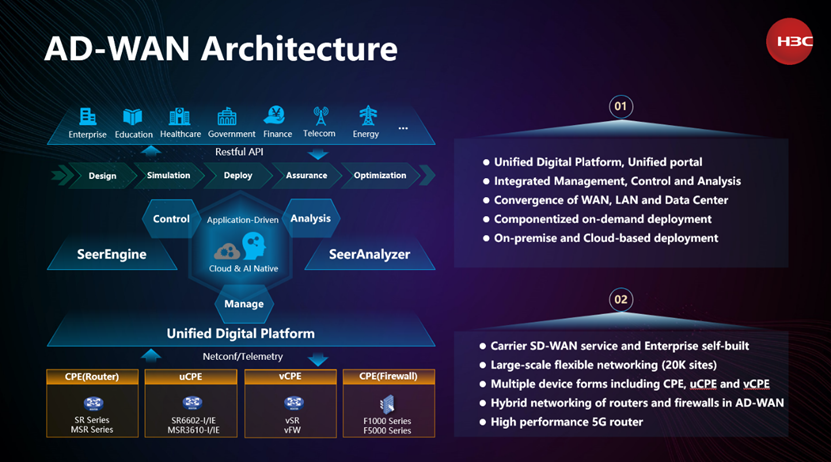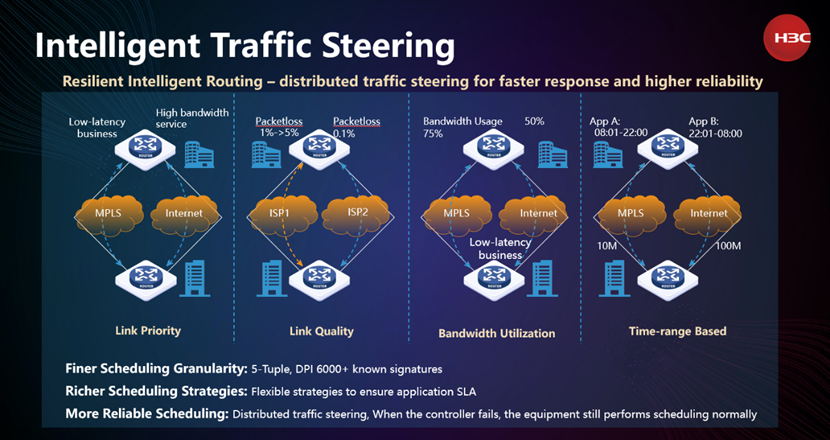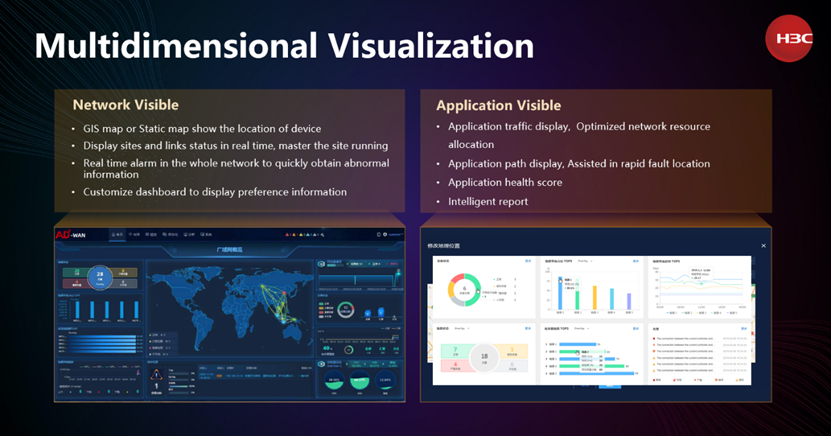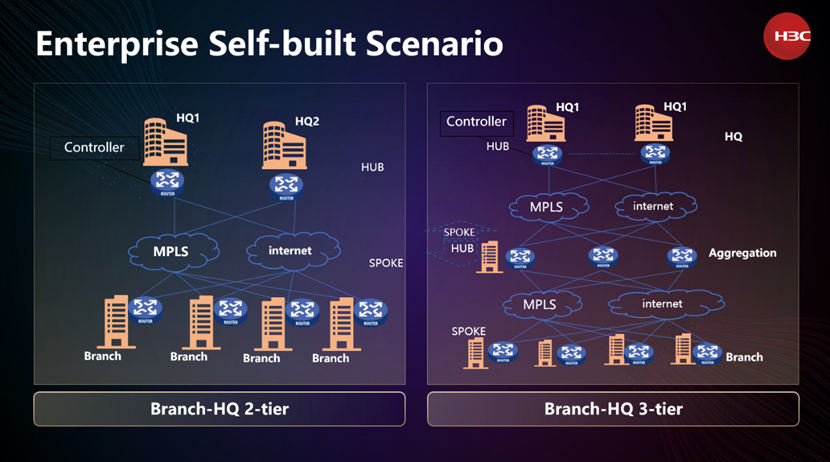 Branch Solution Introduction_2377042_294551_0.jpg)
H3C Application-driven Wide Area Network (AD-WAN) Branch Solution Introduction
H3C AD-WAN branch solution adopts the standard SDN network architecture and is a converged, layered, open, and intelligent network technology architecture. The AD-WAN branch solution integrates the intelligent management module, intelligent control module, and intelligent analysis module to achieve the three-dimensional integration of "management", "control", and "analysis". It is user-oriented and has a unified portal, truly achieving "one-time login, one-click issuance, integrated guarantee, and one-stop operation and maintenance". It combines big data analysis and AI learning capabilities to capture real-time snapshots of the network and offline modeling, realize intelligent prediction and intelligent troubleshooting of the network, and help users achieve intelligent upgrades of digital networks.
Why do we need AD-WAN Branch?
As digital transformation deepens and new businesses continue to emerge, more and more applications are being migrated to the cloud, and multi-cloud connections of public, private, and hybrid clouds have become the new trend. As applications become cloud-based and intelligent, business demands for WANs have also changed, and WAN traffic has surged, driving changes in WANs. At this point, software-defined WANs have become the key to network reconstruction in digital transformation.
H3C's AD-WAN branch solution is aimed at enterprises, energy, finance, transportation and other industries, providing full-scenario on-demand interconnection between branches, branches and data centers, and branches and clouds. It also provides users with a better business experience through ZTP zero-configuration online, intelligent routing, WAN optimization, intelligent operation and maintenance, and full-process security.

What are the key technologies of AD-WAN branch?
Zero Touch Provisioning (ZTP)
The AD-WAN branch solution provides a variety of automated deployment (ZTP zero-configuration online) capabilities, supporting unified configuration distribution and operation and maintenance management after the equipment is automatically launched. Zero-configuration deployment relieves the pressure on enterprise network management personnel, reduces complicated deployment and operation and maintenance work, and reduces labor costs.
Automation deployment
The AD-WAN branch solution supports the following automated deployment content:
- Automatically deliver VPN services, LAN services and QoS services across the entire network.
- Define applications based on fields such as IP quintuple, DSCP, VPN, and application message characteristics.
- Customize application policies based on optimal link requirements, bandwidth requirements, and application quality requirements (delay, jitter, and packet loss rate), and deploy policies based on specified time periods.
- One-click configuration delivery through the AD-WAN interface.
Intelligent traffic scheduling
H3C AD-WAN branch solution provides multiple scheduling strategies:
- Scheduling based on factors such as bandwidth utilization and link coloring. Assuming that two services are normally on the same link, as the link bandwidth utilization gradually increases, when the link utilization reaches the set threshold, the device automatically schedules the abnormal link service to another high-quality link based on the corresponding scheduling policy issued by AD-WAN to ensure user experience.
- Scheduling based on factors such as latency, jitter, and packet loss rate. Assuming that two services are normally on the same link, when the link latency exceeds the threshold set by the user, the device automatically schedules the abnormal link service to another high-quality link based on the corresponding scheduling policy issued by AD-WAN to ensure user experience.
- Based on time period scheduling and periodic business scheduling, high priority business can be guaranteed and scheduled within a certain time period to ensure business reliability requirements.

WAN Acceleration
Supports WAN acceleration and optimization for applications through technologies such as TFO, DRE, LZ, Web Cache and FEC.
- TFO refers to transport layer flow optimization technology. Without changing the source and destination IP addresses and port numbers of TCP traffic, TCP connections are transparently proxied at both ends of the WAN link, and TCP traffic at both ends of the WAN link is optimized.
- DRE refers to the technology of eliminating redundant data. The data dictionary corresponding to the duplicate data blocks and dictionary indexes is stored on the WAAS devices that communicate with each other. Before sending data, the dictionary is first searched. If the dictionary table entry of the data block is found, it is considered that the data block has been sent before and is called a duplicate data block. The sender replaces the duplicate data block with the dictionary index and transmits it on the WAN link. The receiver identifies the dictionary index and restores it to a duplicate data block to reduce the amount of data transmitted on the WAN link and increase the data transmission speed. The process of replacing duplicate data blocks with dictionary indexes is called DRE compression. The process of replacing dictionary indexes with duplicate data blocks is called DRE decompression.
- LZ compression is a data lossless compression technology. It mainly uses a self-built dictionary method to perform compression replacement, and its compression dictionary exists in the compression result. Compared with DRE compression, LZ compression has a lower compression rate, but it does not need to save the data dictionary synchronously on both the compression and decompression sides, so the memory overhead is relatively small.
- Web Cache: The device caches the web page content of the specified address accessed by the user through the HTTP/HTTPS protocol locally. During the cache aging time, when the user accesses the same content, it will respond quickly directly from the local. Using this technology can increase the application download speed by more than 4 times and the web page access efficiency by 1 times.
- FEC: Automatic forward error correction, through end-to-end link quality detection, automatically calculates and adjusts the data packet redundancy ratio according to the real-time link packet loss rate, ensuring a low packet loss rate without sacrificing too much link bandwidth. It can significantly reduce the impact on real-time applications (video conferencing, voice calls, etc.) caused by using low-SLA level links such as the Internet.
Visual monitoring and maintenance
The AD-WAN branch solution has a variety of reporting and large-screen tools, allowing operation and maintenance personnel to check network status in a timely manner.
- Network visualization, supporting GIS map integration.
- Based on various topology presentation methods such as sites and links, obtain alarms or abnormal information in the first time when network equipment or links fail.
- Customized Dashboard, which can customize the visualization screen according to the preferences and concerns of different operation and maintenance personnel .
The AD-WAN branch solution can intuitively present the visualization status of applications, such as TopN application traffic display, application path display, and health status, etc., to help operation and maintenance personnel understand the operation quality of applications in real time and assist in rapid positioning.

What are the typical application scenarios of AD-WAN branches?
Enterprise self-built scenarios description

AD-WAN branch solution supports the common Hub-Spoke two-level network and the three-level architecture network of large enterprises, supports hybrid access of dedicated lines and Internet links, and is suitable for enterprise networks with a large number of branches and dispersed locations. The enterprise self-built scenario is mainly based on vertical traffic, and the enterprise's key business is distinguished and identified through ACL, DPI, etc.
Key features
- Based on application scheduling of dedicated lines and Internet lines, different application traffic can go through different links according to quality, bandwidth, and preferred path.
- Fully utilize line bandwidth, support line switching, and ensure the carrying of key services.
- When a link fails, it supports automatic control and automatic adjustment of the path for the application.
- Support WAN acceleration optimization.
- Multi-dimensional business visibility.
- Provide high reliability assurance from the forwarding, control, and management planes.



